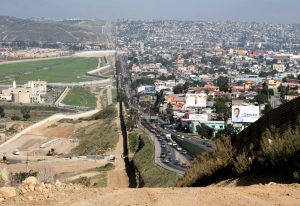National Guard at the Border Not a New Thing
In another attempt at distracting the public from the many political and legal battles he faces, Donald Trump this week turned to one of his favorite targets to pick on, again using immigration as
a piñata.
This time, Trump’s attack on immigration came in the form of the National Guard, declaring his intention to send citizen-soldiers to help secure the border and stop the flow of undocumented immigrants he claims are both at record highs and record lows.
In one tweet Trump claimed there are record numbers of people flowing across the border, yet in another tweet he claimed his administration has reduced illegal entries to the lowest level in 46 years.
Well, which one is it?
Regardless of the true facts about border crossings, Trump’s exaggerated claims that the National Guard will secure the border is just another Trump embellishment aimed at appeasing his political base.
Calling on the National Guard to assist the Border Patrol isn’t a new idea, and Trump surely wasn’t the first President to deploy troops to the Mexican frontera.
On May 15, 2006, then-President George W. Bush gave a nationally-televised speech outlining his new approach to immigration reform, including hiring 6,000 new Border Patrol agents and mobilizing up to 6,000 National Guardsmen under the coordination of the governors of California, Arizona, New Mexico, and Texas.
The plan called for the National Guard to assist and support the Border Patrol by operating surveillance systems, analyzing intelligence, installing fencing and barriers, building roads, and transporting detainees, thereby freeing up more Border Patrol agents to enforcement duties.
The plan, called Operation Jump Start, specifically outlined that Guardsmen would not directly detain undocumented immigrants or carry loaded rifles; their roles was strictly in support of Border Patrol agents, providing extra manpower to allow more agents to return to the front lines. Although the federal government would fund the Guard’s activities, they would remain under the control of the four state governors.
The plan later called for five specific missions: (1) relieve Border Patrol agents of non-law enforcement duties, including vehicle maintenance, training, and administrative duties;
(2) perform surveillance and reconnaissance duties; (3) enhance intelligence and communications capabilities; (4) provide ground and air transportation services, and processing a removal of detainees; and (5) construct fences, roads, camps, and detention facilities.
By the second year of the operation, National Guard personnel dropped to about 3,000, and the operation ended on July 15, 2008, 25 months after it began.
But, that wasn’t the last time the Guard was called into action along the border.
In July 2010, President Barack Obama called on the Guard to again help along the border. Operation Phalanx, as it was called, authorized up to 1,200 Guardsmen to assist Border Patrol by using helicopters and electronic systems to detect and monitor illegal crossings of both people and contraband. Still, the Guardsmen where not allowed to directly engage or arrest suspected undocumented immigrants, only to provide support.
As timely as the debate over deploying troops to the border may be now, the first use of the National Guard along the border predates any of our living Presidents.
It was President Woodrow Wilson that, in 1916, first called upon citizen-soldiers to assist in patrolling our border with Mexico.
What prompted the need for the National Guard at the border in 1916?
Pancho Villa.
After Villa’s attack on Columbus, New Mexico, in May 1916, President Wilson sent Brigadier General John Pershing into Mexico to track down the rebel. In what was the first American use of motorized vehicles in a military operation, Gen. Pershing led a force of about 10,000 American Army soldiers in Mexico, and set off an embarrassing campaign that eventually forced Pershing to return to the US without having captured the cunning Villa.
But, during Pershing’s Punitive Campaign, as it was later called, the border was left unsecured at a time of continuing cross-border raids from Mexico. That led President Wilson to call up the National Guard to help patrol the border.
After Pershing returned from Mexico in February 1917, the Guard’s border operation was demobilized, but not before over 140,000 National Guardsmen from every state (except Nevada, with at the time still didn’t have a Guard) rotated through their border duties.
During that first border assignment, the Guard provided mostly security and monitoring duties along the frontier, and did not directly engage in border skirmishes. The National Guard helped play a defensive role, but not as a fighting military force.
It wasn’t until 1924 that the US Border Patrol was created with the primary duty of securing the US borders, relievin ag all Army soldiers at the border.
The current proposal to deploy the National Guard to the border should be viewed in context of the legal limits our military has to enforce civil law.
The military cannot actively patrol the border, arrest suspected undocumented immigrant, or even worse, use lethal force at will. As in the case of Bush and Obama, Trump’s call-up of the National Guard will be in a support role, and remain under the control of border state governors, including Jerry Brown.
In the end, the mobilization of the National Guard is more a show of force than a true change in immigration policy.
If Trump wants to pretend to be a tough guy on immigration, that’s not a surprise; but what may come as a shock to him will be when he realizes there won’t be armed soldiers along the border, standing shoulder to shoulder from San Diego to the Gulf of Mexico.
Maybe, when he realizes there is a Gulf of Mexico, Trump will start tweeting about changing it to the Gulf of America, and shift his focus to another shiny object for a while, leaving the serious task of immigration reform to more serious people.


 Arturo Castañares
Arturo Castañares



